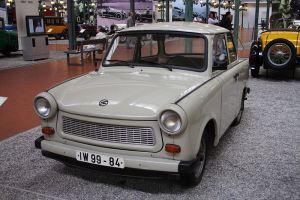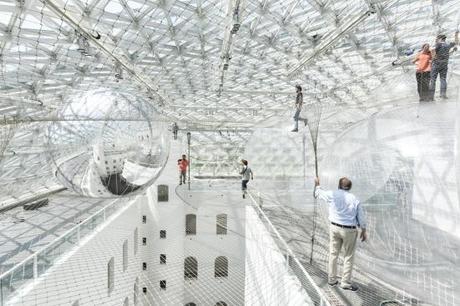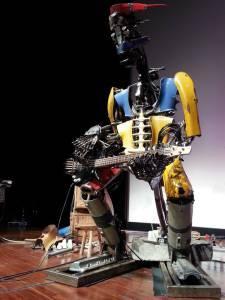In 2008, the number of people living in cities surpassed those living in rural areas, and that number is set to rise. So what does this mean for cities? What will the city of the future look like? What will Berlin be like? These questions brought designers, architects, engineers and artists together for this year’s TedxBerlin Conference.

David Owen, author of Green Metropolis and staff writer at The New Yorker, nodded to this lesson by saying that the best urban planning ideas (and ideas in general) came about by accident. New York, for example, due to geography and chance, grew upwards, instead of sprawling outwards, resulting in the greenest city in the U.S.
New York boasts the lowest per capita energy consumption, lowest per capita waste production, lowest rate of automobile ownership and the only significant transit users in the country. This is due to density, which results in smaller living spaces, less consumption, and walking or public transport becoming the main way of getting around.

This idea was reiterated by Zhang Yue, Champions of the Earth Winner and one of the main people behind this incredible project:
There has been much talk about the cost, speed of construction and height of this building, which will become the tallest in the world when it is completed next year. Most significantly though, this building will contain an entire city; schools, shops, offices – everything a society needs, apart from a crematorium. A ramp will enable cyclists and drivers to travel right up to the 202nd floor, although of course, Yue has envisioned a city in which everything is accessible by foot.
Clearly, cities in China cannot keep sprawling, and the old model of having living quarters in one area and commercial or industrial districts in another, is unsustainable. If China continues at its current pace, it will soon have as many cars per capita as the U.S – that’s one billion cars – and the planet will be ruined. In addition to reducing air pollution, this building will be well-insulated, have quadruple-glazed windows, and be six times more energy-efficient than the average building.
Pollution seemed to be a pervading concern. An oft-quoted statistic was from the World Health Organisation, stating that air pollution kills more people per year than AIDS and malaria combined.
One brilliant solution referred to by several speakers was titanium dioxide. It’s used to make Skittles and M&Ms hard but more to the point, it absorbs air pollution. Unfortunately, it’s not as easy as covering everything in M&Ms as Berlin-based architect Allison Dring highlighted during her presentation about her work producing 3D modules from the material for the facade of hospital Torre de Especialidades in Mexico City:
It seems that architects will have an increasingly scientific dimension to their work in the future.
In general, there appears to be a blurring of boundaries between the work of architects, engineers, artists and designers. Take the brilliant installation art of Tomás Saraceno:

It is a combination of architecture, science and art. In his series creating 3D spider webs, he even found himself being quoted in scientific papers, although he is not a scientist.

In the early 90s, Kugler collaborated with The Mutoid Waste Company, creating guerilla art out of leftover military equipment – including a Mig 21 fighter plane – in the wasteland that was Potsdamer Platz.
Kugler, who once wanted to be a zoologist, demonstrated how he sees natural shapes in man-made objects, and how chance plays a role in his work. He emphasised the importance of making good machines that reflect nature.
Indeed, art is an important part of the city. Cultural advisor Michael Schindheim recently worked on plans for Hong Kong’s West Kowloon Cultural District, made to address the fact that, for such a major city, it lacks a strong cultural identity. Berlin seems to have the opposite dynamic; we are rich with art, but not industry.
So what is it about Berlin that fosters creativity? James Patten, involved in projects such as the Gravity Harp for Bjork, Chicago Museum of Science and Industry’s interactive periodic table, and my favorite, the Barista Bot, which draws your portrait on your caffè latte, provided illumination. While working at The Metropolitan Exchange in New York, he pinpointed several optimal conditions for creativity; having a half-finished space – or a space that feels like it’s in progress – to work in, having a mix of random objects at hand to play with, and having a range of people from all disciplines who share a vision and are willing to muck in. Berlin ticks all of these boxes (as Kugler’s work demonstrates).
Overall, Berlin came out pretty well as a city. Due to Kiez culture, everything we need accessible by foot, resulting in a relatively green city (we could do better with energy efficiency, for example, by insulating old buildings and using LED lights).
There is a wealth of community-based, down-up projects, like the mini-gardens that have been cultivated around trees by the residents of Oderbergerstrasse in Prenzlauer Berg. This trend is set to grow; Priya Prakash is keen to roll out Changify in this city, although we still have a long way to go before we catch up with the Mayor of Seoul, who has installed a giant ear in his city that transmits the public’s complaints directly to city hall. The boundaries between people and governments are also set to blur through increased use of social media and technology.
We have the Flussbad to look forward to, which means that we might see people swimming around in the river near Museums Insel in the near future:
Berlin has great potential due to its abundance of unused space, and space that can be creatively re-purposed. Merkel’s recent pledge to make Germany nuclear power free, also creates opportunities to use more renewable energy and rely on energy loops (waste from one thing being used as food for another).
Two very important talks drew our attention to those people in places not as fortunate as us. Writer and film-maker Lina Hadsbjerg focussed on the lives of refugees living in the inner city of Johannesburg, South Africa. I’d be interested in watching her documentary Into the Shadows to find out more:
On a similar note, photographer Alessandro Grassani presented his photos of environmental immigrants in Bangladesh and Mongolia. In 40 years time, every 1 in 45 people will be an environmental migrant; 90% of these will be from the poorest countries, and as is often the case, the problem will affect the world’s poorest people.
The message is clear – cities are getting better, but there are still many growing challenges that need to be addressed.
If you want to watch any of the talks mentioned or find out more, visit the TedxBerlin website.
Filed under: art, Berlin, Life in Berlin, News
